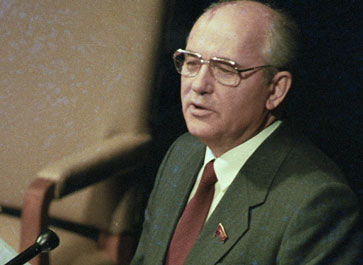Mikhail Gorbachev: The last Soviet leader
He believed glasnost ("openness") and perestroika ("reformation") were necessary
Though he was president-elect, George Bush was still Ronald Reagan's vice president when Soviet leader Mikhail Gorbachev came to New York's Governor's Island in December 1988. Gorbachev met chiefly with President Reagan but was likely hoping to build a rapport with his future counterpart. Bush, however, decided to stay mostly in the background, skeptical of what the Russian reformer could truly accomplish. But he did ask Gorbachev what investors could expect from the U.S.S.R. "Even Jesus Christ," replied the latter, "couldn't answer that question."
The head of an officially atheistic nation, Gorbachev likely would not have liked God's answer in any case: Three years later, on Christmas Day in 1991, he would resign, the final leader of America's erstwhile superpower rival.
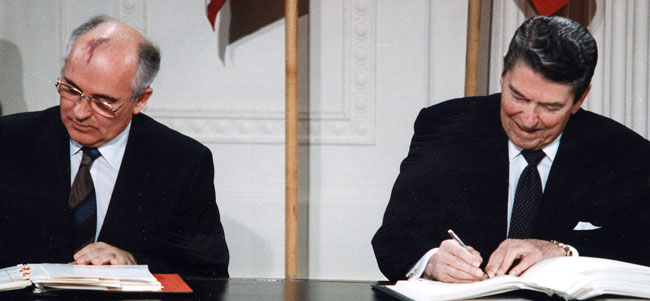
THE PAUSE
President Bush and his team, notably National Security Advisor Brent Scowcroft, entered office wary of Gorbachev and critical of Reagan's approach toward him. Gorbachev had used his visit to New York to announce major troop withdrawals from Eastern Europe and along the Chinese border. He also suggested a commitment to self-determination among people the U.S.S.R. had previously dominated.
It is evident that force and the threat of force can no longer be, and should not be instruments of foreign policy. The compelling necessity of the principle of freedom of choice is also clear to us.
Mikhail Gorbachev, December 7, 1988
But Bush and his advisors, Cold War veterans, had seen much of this before. Were these overtures simply a way to take advantage of the United States? And if Gorbachev himself was serious about glasnost (openness) and perestroika (restructuring), what was to prevent communist hardliners from reasserting dominance and returning to a more confrontational stance, much as they had done with a previous reformer, Stalin's successor Nikita Khruschev?
The administration decided to pause and move no further on substantive talks until a review of the entire relationship had been completed.
MALTA
A trip to eastern Europe in July 1989 changed the president's perspective. Bush saw the great rush of events in the region with his own eyes, and leaders of nations trying to manage the rapid changes, particularly Poland and Hungary where reforms were underway, asked him to work with Gorbachev to create stability.
"I realized that to put off a meeting with Gorbachev was becoming dangerous," remembered the president later. "Too much was happening in the East—I had seen it myself—and if the superpowers did not begin to manage events, those very events could destabilize Eastern Europe and Soviet-American relations." Returning home on Air Force One the president invited Gorbachev to a summit, and the two sides eventually agreed to convene at Malta, an independent island nation in the center of the Mediterranean Sea, in December.
Rapid changes in Eastern Europe
-
November 1988: Estonia declares sovereignty, asserting its right to reject the laws of the Soviet Union. (Estonia declared its full independence on March 30, 1990.)
-
May 1989: Lithuania declares sovereignty. (Lithuania declared its full independence on March 11, 1990.)
-
June 1989: Poland holds elections, with the non-communist Solidarity Party winning all but one freely contested seat.
-
June 1989: Hungary begins to dismantle the fence dividing it from Austria
-
July 9-13, 1989: Bush travels to Poland and Hungary.
-
July 1989: Latvia declares sovereignty. (Latvia declared its full independence on May 4, 1990.)
-
September 1989: East Germans begin moving through Hungary to Austria
-
October 1989: Hungary proclaims its status as a republic with free multi-party elections to take place the following year.
-
November 1989: The Berlin Wall falls
-
December 2–3, 1989: Bush and Gorbachev meet at Malta
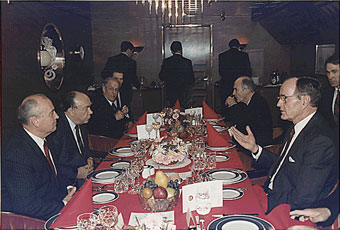
There was little of substance decided at Malta. The administration wanted to move deliberately, using the meeting, in the words of a briefing memo penned by Secretary of State James Baker III, to generate "a public sense, here and abroad, of a new pace and purpose to the U.S.-Soviet dialogue with you leading as much as Gorbachev." And while there was progress on issues such as START (the Strategic Arms Reduction Treaty eventually signed in July 1991) and reductions of troop levels in Europe, the more important moments were symbolic.
Gorbachev stated publicly, "I assured the President of the United States that I will never start a hot war against the USA. The world is leaving one epoch and entering another. We are at the beginning of a long road to a lasting, peaceful era." And Bush said, "We can realize a lasting peace and transform the East-West relationship to one of enduring co-operation. That is the future that Chairman Gorbachev and I began right here in Malta."
Scholars continue to debate whether the conference was a critical step in the peaceful resolution of the Cold War or a missed opportunity in the quest for democratic values to take hold in the former Soviet Union.
1990: GERMANY, THE BALTIC STATES, AND NATO
When Bush welcomed Gorbachev to Washington in late May 1990, Europe had undergone dramatic changes. The Soviet republics of Lithuania, Latvia, and Estonia had all declared their complete independence from the U.S.S.R. And a united Germany sitting at the heart of Europe—unimaginable at the end of Word War II—now appeared inevitable. (For more on the particulars, see the Statecraft article "The Fall of the Berlin Wall.") The real question was the role of NATO in continuing developments, and in particular, would a united German state be a part of the organization?
In March, 1990, Gorbachev had unequivocally said no: "We cannot agree to a united Germany being part of NATO. It is absolutely ruled out." But sitting with Bush, the Soviet leader agreed to the principle that a united Germany could choose for itself which international organizations to join. Bush's staff was so surprised, they asked the president to confirm the commitment. And though Bush did agree to one trade deal at the summit, he largely refrained from giving the Soviet leader significant economic assistance.
COUP AND COLLAPSE
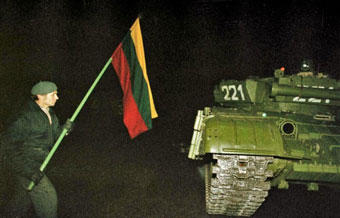
Despite concessions on German reunification, which ultimately took place in October 1990, the Soviet Union was still a nuclear superpower, and the fate of its member republics was still in question. In January 1991, Gorbachev sent tanks into both Lithuania and Latvia to halt democratic uprisings. But he faced significant pressure from both Communist hardliners, one the one hand, and advocates of faster democratic and economic reforms, especially Russian Soviet Republic President Boris Yeltsin, on the other. The Bush administration wanted to support Gorbachev as the best hope for a peaceful and stable end to the Cold War, but it was clear his power was waning.
Bush travelled to Moscow to sign the landmark START treaty in late July, not only securing a major reduction in nuclear warheads and deployment systems, but also showing solidarity with the weakening Gorbachev. At the same time, U.S. officials began to develop ties to Yeltsin.
Gorbachev looks less a man in control and more an embattled leader.
Jack Matlock, U.S. Ambassador to the Soviet Union, May 11, 1990
Gorbachev was in the midst of a final push to save the U.S.S.R. from total collapse, proposing a new union treaty to give republics increased independence as part of a new—and re-named—federation to be called the Union of Sovereign States. No longer would the nation be either Socialist or Soviet. On August 19, communist hardliners reacted with a coup attempt, as eight officials declared themselves the State Committee on the State of Emergency and sent tanks into the streets of Moscow while detaining Gorbachev and other key leaders.
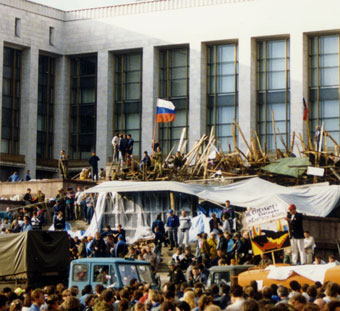
But the coup plotters were no more powerful than the man they were attempting to replace. Yeltsin had already led Russian defiance of Soviet laws, and he promptly issued a declaration calling for a general strike, urging the military not to take part in the coup, and demanding Gorbachev be allowed to speak. When Yeltsin climbed atop a tank to address crowds in the streets, it became immediately clear that the coup was destined to fail. Though Gorbachev returned to office on August 22, his power, too, was at an end, and he swiftly resigned as the general secretary of the Communist Party.
One by one, Soviet republics began to declare their independence, and on December 25, 1991, Gorbachev resigned as the President of the U.S.S.R. The following day, the Supreme Soviet's Council of Republics, voted the nation itself out of existence.

